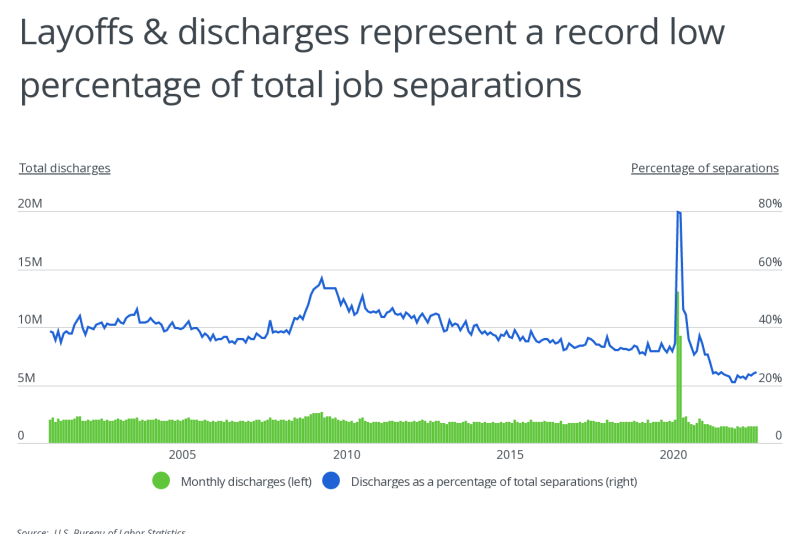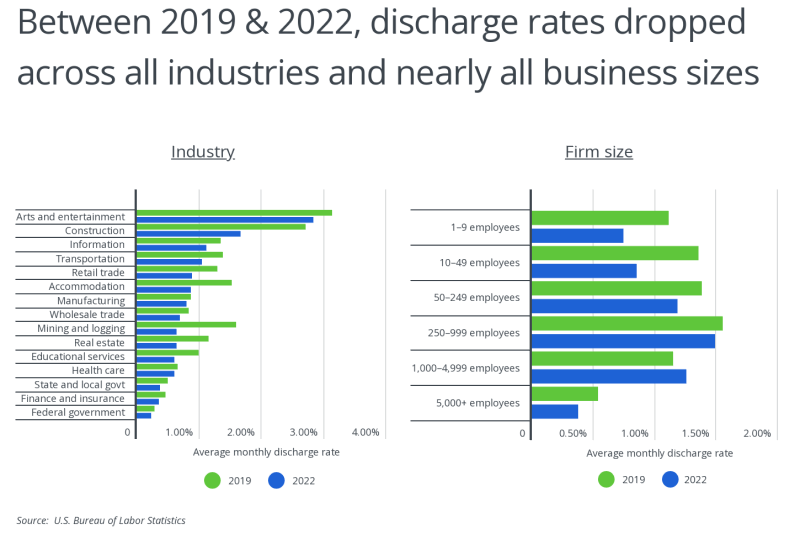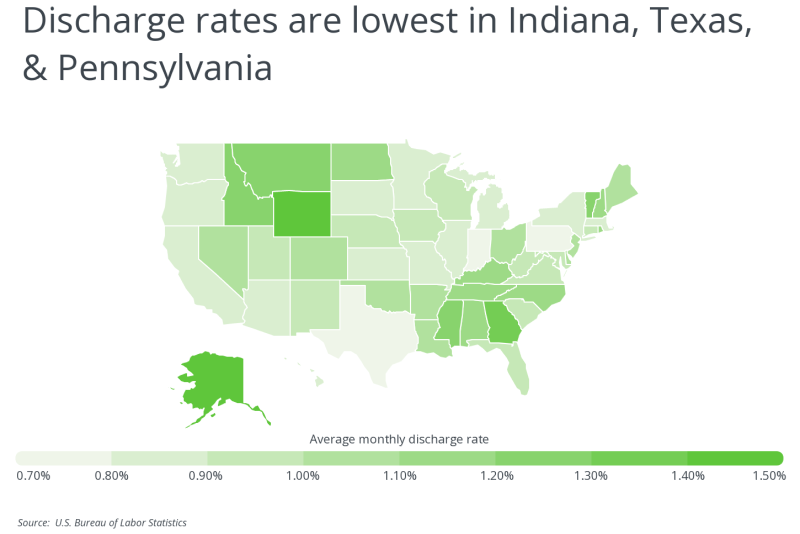States Where Existing Workers Are Highly Unlikely to Lose Their Jobs
 Photo Credit: GaudiLab / Shutterstock
Photo Credit: GaudiLab / Shutterstock
December 1st, 2022
Amid high inflation, rising interest rates, and low consumer confidence, there is good reason to be pessimistic about the state of the U.S. economy for the rest of 2022 and 2023. But despite these challenging conditions, one component of the economy that has continued to deliver good news is the labor market.
The unemployment rate in the U.S. sat at 3.5% in September, one of the lowest figures in more than half a century. Despite low unemployment, the economy has added jobs every month dating back to January 2021. These conditions have been advantageous for workers. The “Great Resignation” brought a historic volume of job switching in 2021 and 2022 as people sought out better job opportunities. This tightness in the labor market has pressured employers to raise wages and offer improved working conditions and benefits to compete for talent.

As a result of these trends, workers have been far less likely to face layoffs and discharges than at any other time in the last two decades. Layoffs and discharges spiked dramatically in the spring of 2020 at the onset of the COVID-19 pandemic. Monthly discharges totaled more than 13 million in March 2020, representing approximately 80% of separations. Since then, however, layoffs and discharges total less than 1.5 million per month, or less than a quarter of all separations. These recent figures fall well below typical levels dating back to 2000.

The trend of reduced discharge rates extends to businesses in every field. Employers in industries like arts, entertainment, and recreation, retail trade, and accommodation and food services that were highly volatile in earlier phases of the pandemic are now reluctant to let go of employees. Other industries that could contract during a potential recession, like construction, are also discharging employees less than in the steadier economic conditions of 2019. Average monthly discharge rates are also down across businesses of all firm sizes.

Discharge rates are also consistently low across the country, but certain locations are seeing slightly higher levels. Alaska and Wyoming currently have the highest discharge rates, with monthly averages of 1.49% and 1.48% of total employment, respectively. States in the South like Georgia, Mississippi, and North Carolina and states in the Mountain West like Idaho and Montana also rank highly. In contrast, states including Indiana, Texas, and Pennsylvania have the nation’s lowest discharge rates.
The data used in this analysis is from the U.S. Bureau of Labor Statistics. To determine the states where existing workers are least likely to lose their jobs, researchers at HireAHelper calculated the average monthly discharge rate across all nonfarm workers in 2022. In the event of a tie, the state with the lower number of total discharges was ranked higher. A discharge represents all involuntary separations, including layoffs, firings, and terminations. Total separations, on the other hand, includes both involuntary and voluntary separations, such as quits and retirement.
Here are the states where existing workers are highly unlikely to lose their jobs.
U.S. States With the Lowest Employee Discharge Rates
 Photo Credit: Sean Pavone / Shutterstock
Photo Credit: Sean Pavone / Shutterstock15. Illinois
- Average monthly discharge rate: 0.86%
- Average monthly discharges: 51,875
- Average monthly total separations: 213,000
- Discharges as a percentage of total separations: 24.4%
 Photo Credit: Jon Bilous / Shutterstock
Photo Credit: Jon Bilous / Shutterstock14. Oregon
- Average monthly discharge rate: 0.86%
- Average monthly discharges: 16,500
- Average monthly total separations: 77,750
- Discharges as a percentage of total separations: 21.2%
 Photo Credit: Sean Pavone / Shutterstock
Photo Credit: Sean Pavone / Shutterstock13. California
- Average monthly discharge rate: 0.85%
- Average monthly discharges: 145,625
- Average monthly total separations: 617,125
- Discharges as a percentage of total separations: 23.6%
 Photo Credit: ESB Professional / Shutterstock
Photo Credit: ESB Professional / Shutterstock12. Massachusetts
- Average monthly discharge rate: 0.85%
- Average monthly discharges: 31,000
- Average monthly total separations: 119,375
- Discharges as a percentage of total separations: 26.0%
 Photo Credit: Jacob Boomsma / Shutterstock
Photo Credit: Jacob Boomsma / Shutterstock11. South Dakota
- Average monthly discharge rate: 0.85%
- Average monthly discharges: 3,750
- Average monthly total separations: 17,000
- Discharges as a percentage of total separations: 22.1%
 Photo Credit: Sergey Novikov / Shutterstock
Photo Credit: Sergey Novikov / Shutterstock10. Michigan
- Average monthly discharge rate: 0.84%
- Average monthly discharges: 35,875
- Average monthly total separations: 157,625
- Discharges as a percentage of total separations: 22.8%
 Photo Credit: IVY PHOTOS / Shutterstock
Photo Credit: IVY PHOTOS / Shutterstock9. Minnesota
- Average monthly discharge rate: 0.83%
- Average monthly discharges: 24,000
- Average monthly total separations: 98,375
- Discharges as a percentage of total separations: 24.4%
 Photo Credit: spyarm / Shutterstock
Photo Credit: spyarm / Shutterstock8. New York
- Average monthly discharge rate: 0.81%
- Average monthly discharges: 76,375
- Average monthly total separations: 267,250
- Discharges as a percentage of total separations: 28.6%
 Photo Credit: ESB Professional / Shutterstock
Photo Credit: ESB Professional / Shutterstock7. Washington
- Average monthly discharge rate: 0.81%
- Average monthly discharges: 28,375
- Average monthly total separations: 123,250
- Discharges as a percentage of total separations: 23.0%
 Photo Credit: Sean Pavone / Shutterstock
Photo Credit: Sean Pavone / Shutterstock6. Arizona
- Average monthly discharge rate: 0.81%
- Average monthly discharges: 24,250
- Average monthly total separations: 141,125
- Discharges as a percentage of total separations: 17.2%
 Photo Credit: Sean Pavone / Shutterstock
Photo Credit: Sean Pavone / Shutterstock5. Kansas
- Average monthly discharge rate: 0.80%
- Average monthly discharges: 11,125
- Average monthly total separations: 49,750
- Discharges as a percentage of total separations: 22.4%
 Photo Credit: Izabela23 / Shutterstock
Photo Credit: Izabela23 / Shutterstock4. Hawaii
- Average monthly discharge rate: 0.80%
- Average monthly discharges: 4,750
- Average monthly total separations: 21,750
- Discharges as a percentage of total separations: 21.8%
 Photo Credit: Gang Liu / Shutterstock
Photo Credit: Gang Liu / Shutterstock3. Pennsylvania
- Average monthly discharge rate: 0.79%
- Average monthly discharges: 46,750
- Average monthly total separations: 187,875
- Discharges as a percentage of total separations: 24.9%
 Photo Credit: Tomas Simkus / Shutterstock
Photo Credit: Tomas Simkus / Shutterstock2. Texas
- Average monthly discharge rate: 0.76%
- Average monthly discharges: 101,375
- Average monthly total separations: 542,375
- Discharges as a percentage of total separations: 18.7%
 Photo Credit: Sean Pavone / Shutterstock
Photo Credit: Sean Pavone / Shutterstock1. Indiana
- Average monthly discharge rate: 0.74%
- Average monthly discharges: 23,750
- Average monthly total separations: 130,875
- Discharges as a percentage of total separations: 18.1%
Detailed Findings & Methodology
The data used in this analysis is from the U.S. Bureau of Labor Statistics Job Openings and Labor Turnover Survey. To determine the states where existing workers are least likely to lose their jobs, researchers at HireAHelper calculated the average monthly discharge rate across all nonfarm workers in 2022. In the event of a tie, the state with the lower number of total discharges was ranked higher. A discharge represents all involuntary separations, including layoffs, firings, and terminations. Total separations, on the other hand, includes both involuntary and voluntary separations, such as quits and retirement.